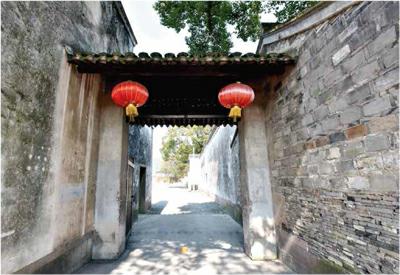橐橐而行醉经阁
碧水
宁波慈城曾经有座醉经阁,藏书很出名。听老辈人述说,当年通往醉经阁的是一条长长的弄堂,经过时,脚步声“橐橐”地在冷冷的高墙间回荡,虚化起严正肃穆的气氛……前些年,笔者在做田野调查时,听说了诸多有关故事。
庋藏之珍
醉经阁主人叫冯云濠。冯家是数世药商,家境素丰,也有文风。冯云濠幼年丧父,读书勤奋,于清道光十四年(1834)乡试中式。他建有藏书阁,阁名“醉经”,取自隋学者王通“心若醉六经,目若营四海”(《中说·事君》)句,潜心经学。阁中藏书数万卷,既多经部、子部之孤本珍本善本,尤多明版之舆地图籍,可见藏书特色。
旧时,有人说,醉经阁与宁波范氏天一阁齐名,这应当是因醉经阁收藏有慈溪郑氏二老阁的藏书,而二老阁的藏书一半得之余姚黄氏续抄堂之故。古代藏书往往有一条轨迹相接,代代传承。江浙藏书宏富,明清时称天下有三得其二,或说十占其七。如今宁波城市口号“书藏古今”,醉经阁大约可为一佐证。
历史上,藏书楼常有整理刻书之举,以显主人身价、学识,并保存文化,用作私家交流。醉经阁也曾刻过一些书,其中《宋元学案》一种,为学界所重。《宋元学案》是思想家黄宗羲的一部未竟的学术史稿,后有多人包括史学家全祖望续修,亦未能完全撰定。冯云濠从鄞县卢氏抱经楼购来这一百卷稿本,与同年王梓材共同校订完稿,并于道光十八年(1838)刻印。这也是后世将醉经阁写入藏书史志之中的重要原因之一。
在校订《宋元学案》的同时,王氏、冯氏又作《补遗》,辑录了四十二卷,后又补充,于道光二十一年(1841)整理出与《宋元学案》正编相同的卷数。由此,两人在学术研究方面也有贡献。据说,“醉经阁,经史子集四部各归其伍,宋元儒文集不下百数十家,藉是以详校《学案》,无待旁借于诸藏书旧家者;即《补遗》之辑,亦是阁有以成也”(王梓材《宋元学案补遗跋》),这也从旁证明了醉经阁藏书的学术价值。
此外,醉经阁所藏之珍,有浙江巡抚曾恒德滋蕙堂刻石。曾氏是特别喜好名人书法真迹的官员,一路仕宦,一路收集,于清乾隆三十三年(1768)撰集刊刻丛帖《滋蕙堂法帖》。后来,曾氏动用巨额库银,请良匠刻石百方,拟作传世,因而削官下狱。救人期间,曾子向慈城冯氏借银垫补,后无力偿还,就以百方刻石抵数。冯云濠谢世后,这些碑刻被后人嵌入醉经阁壁间。
散失之谜
醉经阁现在已不在,其原因是发生窃书之案。笔者在宁波市档案馆查阅过旧报章上有关报道。
第一次重大窃案发生在1920年。当年7月21日、8月10日、8月13日《时事公报》报道:
《藏书被窃》:慈溪冯氏醉经阁藏书楼……其所藏之书半系宋明板木……平时不准闲人登楼,此次不知如何被业古董者潜入楼中将宋板大书四十二部窃出运至上海售于某书局,得价银二万元,前日因分赃不平,互相攻讦,致被楼主人得悉,即联名禀县请究。
《失书案定期传讯》:兹闻窃贼蒋高明获案后供是书卖与宁波三礼堂、三余堂两家等。
《藏书被窃又一说》:兹探悉蒋高明……刁狡异常,于窃取之书售与掮客金某一层虽叠经审究,坚不承认。查本案初因(族人)冯智先债台高筑将父遗书籍售与高明,并谈及醉经楼藏书之富,(以致祸端)。
第二次重大窃案发生在1935年。当年4月21日《时事公报》报道如下:
《醉经阁珍籍私运出境截获后》:慈溪冯氏醉经阁藏书丰富,版本珍贵,与宁波范氏天一阁,为浙东有数之藏书楼。前夜(十九日)竟发现有人将阁中珍籍偷贩运沪,售与日人,经县政府中途截获,亟录详情如次
[偷贩装运 幸经截获]十九日晚间……有江苏吴县人书贾李劲庵、杨彭龄等,偷贩醉经阁图籍,已成交待运,(县府)立饬车站轮埠警丁,守候查截……至则果见书籍十余大包,已经装就,正待挑运,有二书贾在旁指点,遂带人到案
[午夜开庭 审问详情]……此次冯氏出卖醉经阁书籍,系出于四房公意,主卖人为房长冯葵仙
[保护文献 决予收买]……已而房长冯葵仙以及介绍卖书人南山嫂,亦均传到……此次偷买珍籍,全系南山嫂所拉拢,即谕发押,冯葵仙、吴书贾二,均交保出外……本县热心保护乡邦文献者之多,决不肯坐视运往外埠,沦于异域,决函旅沪殷绅,筹款收买
古代藏书楼多有风雨沉浮。其实,醉经阁在遭遇这两次窃案之前,冯氏后人有零星不断的盗卖,“其精华之被潜移默运者久也”(1935年《文澜学报》第二卷第一期),只是不被外界所详知罢了。
残存之幸
1936年,醉经阁第二次被盗追回的珍籍由同邑秦氏抹云楼作价收藏,主人秦润卿有日记一一記录:
1936年1月3日,晴。商售醉经阁存书。
7月24日(晴)。抹云楼承买醉经(阁)书籍,先送来二千册,整理晒之。过了两天(晴)。整理书籍半天,醉经阁又来书四千余件,非一星期不能整齐,惟书橱新做既不及,冯氏意见分歧,未允价卖,殊一难事也。
27日(晴)。请干欐卿、钱炳南等整理书籍,向醉经阁借书橱八口。
8月6日(晴)。冯葵仙到抹云楼参观。冯葵仙为1935年窃书案的主卖人,不知其是否羞惭,要可知曾祖父的藏书藏入他姓的书楼,这可是其祖先一生的心血哟?!
这年11月,秦氏再次买尽醉经阁所剩无多的残书,庋藏抹云楼。
此外,据文献资料查考,醉经阁其他失窃书籍,部分为宁波冯氏伏跗室收藏,其余流失在民间。
新中国成立后,抹云楼藏书归入浙江图书馆,伏跗室藏书归入天一阁,慈城的文粹终得更好归宿。endprint
需要特別说一下的是,醉经阁《宋元学案》一百卷雕板久被焚毁,故流传较少,仅见北京图书馆入藏,后有翻刻本,今已列入《中国古籍善本书目》。《宋元学案补遗》一百卷,当年未及刊印而冯云濠、王梓材先后去世。数十年后,此稿本由王氏之孙售于鄞县屠氏古娑罗馆,后为藏书家张寿镛访得,即着手整理,历五年寒暑,初由原稿录副,一校再校,于1937年刻入《四明丛书》第五集。《宋元学案补遗》最初之四十二卷传抄本今藏于伏跗室。
书去阁空。醉经阁拆除时,滋蕙堂石碑遭丢弃,被附近居民随便抬去做了石凳或灶底石。1986年,宁波江北区文物管理所出资搜集回三十多方,保管陈列,计有唐拓《灵飞经》《心经》,王羲之、褚遂良、虞世南、怀素、锺繇、欧阳询、颜真卿、柳公权、米芾、苏轼、黄庭坚、赵孟頫、鲜于枢、董其昌书法,《滋蕙堂法帖》姜宸英、梁同书跋,曾恒德跋,醉经阁冯氏友人跋。这总算一代名刻也有所存留。
醉经阁只剩故事在慈城流传。笔者钩沉这文史往事时想,如果通过天一阁、浙江图书馆、国家图书馆等公共图书馆来讲述醉经阁的珍藏,说不定更为精彩。
(除署名外,本文图片由梁凤英提供)
Zuijingge Library in Cicheng
By Bi Shui
Zuijingge Library in Cicheng, Ningbo is now a memory. Famed for a collection of ancient books, it was established and owned by Feng Yunhao from a local family engaged in pharmacy business for generations. He successfully passed the imperial examination at the provincial level in 1834, the 14th year of Emperor Daoguang of the Qing (1644-1911). He started the collection and named it Suijingge, meaning drunkenly absorbed in classic studies, based on a sagacious statement by scholar Wang Tong of the Sui Dynasty (581-618).
Zuijingge is no more due to theft. The first damaging theft occurred in 1920. Forty-two Song editions were stolen from the library and sold to a bookstore in Shanghai for 20,000 silver dollars. A dispute erupted among the thieves as they disagreed how to share the filthy lucre. In 1935, another major theft occurred. The thieves were caught. The two major thefts were covered in press. Actually they were stolen and sold by descendents of Feng Yunhao. A local book collector surnamed Qin bought several thousands of books from the library in 1936 and put them into his own library called Moyunlou. Historical literature indicates that Fufushi Library owned by someone surnamed Feng in Ningbo also came into possession of a part of the Zuijingge collection. After the Peoples Republic of China came into being in 1949, Moyunlous books all went to Zhejiang Library and Fufushis collection merged into Tianyige Library in Ningbo.
The collection was famed for its rare and good editions of books published in the Ming Dynasty (1368-1644). Some books were in the category of Classics and some in the category of Masters. It also boasted quite a few collections of maps published in the Ming Dynasty. It was said that Zuijingge Library equaled Tianyige Library in Ningbo in terms of books in its collection. The comparison was understandable: part of the books in Zuijingge Library came from a private collection previously owned by two brothers of Zheng Family in Cixi. And the half of the collection in the possession of the two brothers had come from another private collection owned by a man surnamed Huang in Yuyao. In ancient China, books often changed hands from one private collection to another through generations. More often than not, a timeline could be established to trace these books from one bibliophile to another.endprint
Zuijingge Library was important for a number of reasons. Feng Yuanhao published , an unfinished history of thought of the two dynasties authored by Huang Zongxi (1610-1695). Scholars after Huang contributed to the completion of the book. The unpublished manuscripts came into Fengs possession. In collaboration with another scholar named Wang Zicai who passed the civil service examination in the same year as Feng did, Feng edited the manuscripts and published the book in 1838. While editing the manuscripts, Feng and Wang added 42 volumes on scholars not mentioned in the original mini-encyclopedia. The two scholars were able to put together the 42 volumes largely thanks to the private collection at Zuijingge Library. The publication of the encyclopedia put Zuijingge into the history of Chinese culture.
Another big treasure of Zuijingge was one hundred stone steles previously owned by Zeng Hengde, a provincial governor of Zhejiang who had passion for calligraphy and built up a collection of works of great calligraphers. In 1768 he published a collection of rubbings of the calligraphic masterpieces in his possession. He went to jail for having used public funds to pay engravers for carving calligraphic masterpieces onto the steles. He mortgaged the tablets to the Feng family to raised funds and returned the funds to the government. Out of jail, he had no money to buy back the steles. The steles became the property of the Feng family. They were embedded into the walls of Zuijingge.
After the collection was gone, the library was soon dismantled. The stone tablets in the walls were thrown away. They were picked up as recycled construction materials and used in homes in the neighborhood. Many were lost. In 1986, a government agency in Ningbo put money up to buy back the lost tablets. Eventually, 30 plus were purchased back. The steles that retain the authentic handwritings of famed calligraphers are now in the hands of the government agency designated for the protection of cultural relics.endprint

